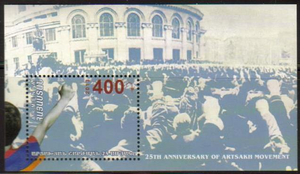Karabakh movement
| Karabakh movement | |||
|---|---|---|---|
| Part of the Nagorno-Karabakh conflict and the dissolution of the Soviet Union | |||

A 2013 post stamp dedicated to the 25th anniversary of the movement showing people with raised fists in Yerevan's Theatre Square and the Opera Theatre in the background in 1988
|
|||
| Date | February 1988 — 1991 | ||
| Location | Armenia (mainly Yerevan) Nagorno-Karabakh Autonomous Oblast |
||
| Goals | Unification of Nagorno-Karabakh with Armenia | ||
| Methods | Demonstrations, sit-ins, strikes, hunger strike, student protest, civil disobedience | ||
| Result | Establishment of the Nagorno-Karabakh Republic Escalation of the Nagorno-Karabakh War |
||
| Parties to the civil conflict | |||
|
|
|||
| Lead figures | |||
|
|
|||
| Number | |||
|
|||
The Karabakh movement (Armenian: Ղարաբաղյան շարժում, also the Artsakh Movement Արցախյան շարժում) was a mass nationalist movement in Armenia and Nagorno-Karabakh from 1988 to 1992 that advocated for the transfer of the mainly Armenian-populated Nagorno-Karabakh Autonomous Oblast of neighboring Azerbaijan to the jurisdiction of Armenia.
Initially, the movement was entirely devoid of any anti-Soviet sentiment and did not call for independence of Armenia. The Karabakh Committee, a group of intellectuals, led the movement from 1988 to 1989. It transformed into the Pan-Armenian National Movement (HHSh) by 1989 and won majority in the 1990 parliamentary election. In 1991, both Armenia and Nagorno-Karabakh declared independence. The intense fighting known as the Nagorno-Karabakh War turned into a full-scale war by 1992.
...
Wikipedia
